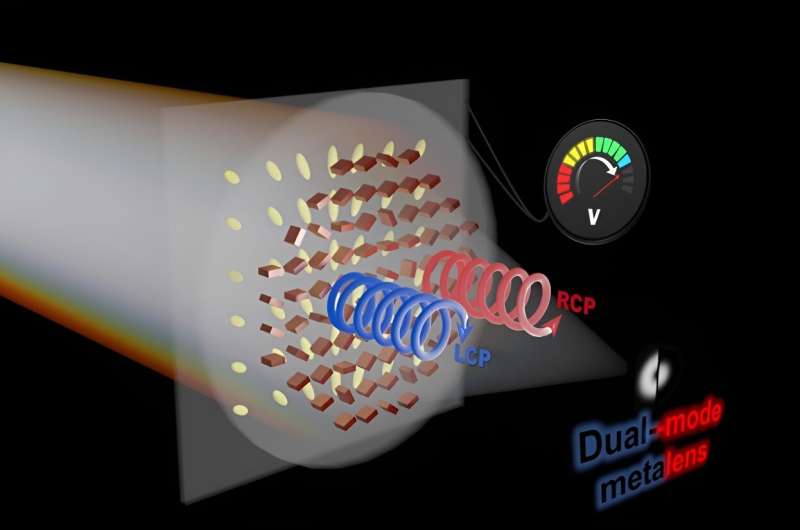This article has been reviewed according to Science X's editorial process and policies. Editors have highlighted the following attributes while ensuring the content's credibility:
fact-checked
peer-reviewed publication
trusted source
proofread
Team develops a dual metalens that can switch between shooting modes based on light conditions

A collaborative research team has successfully engineered a dual metalens capable of switching between different imaging modes using a single lens. The research findings have been featured in ACS Nano.
Typically, during the process of photographing an object, two distinct modes are employed: the normal mode, which extracts fundamental information; and the edge mode, which focuses solely on outlining the object. These modes traditionally require separate lenses, each with different focal points. However, in response to the recent trend towards miniaturization and lightweight design in electronic devices, researchers have been diligently working on integrating both modes into a single lens.
In this study, the team tackled the issue using metalenses that can dynamically alter their focal point through electrical means. These metalenses, without concern for the properties of light, are constructed from nanoscale artificial structures. By fine-tuning parameters like size, shape, and rotational orientation of these structures, the team successfully engineered a dual-mode imaging metalens capable of transitioning between normal and edge modes based on the direction of light polarization rotation.
This lens can swiftly modify its focus by adjusting the voltage applied to the liquid crystal (LC) layer, allowing for rapid mode-switching in mere milliseconds (a millisecond is one-thousandth of a second), matching the speed of liquid crystal switching.
In this research, the team employed hydrogenated amorphous silicon as the nanostructure, known for minimal losses in the visible light region, resulting in remarkable lens efficiency at 32.3%, 31.7%, and 20.4% for red, green, and blue wavelengths respectively. By integrating two distinct modes within a single lens, the team achieved the acquisition of high-resolution images.
The work was led by Professor Junsuk Rho from the Department of Mechanical Engineering and the Department of Chemical Engineering, Trevon Badloe from the Graduate School of Artificial Intelligence, and Yeseul Kim and Joohoon Kim, Ph.D. candidates from the Department of Mechanical Engineering at Pohang University of Science and Technology (POSTECH), and Professor Inki Kim from the Institute of Quantum Biophysics at Sungkyunkwan University
Professor Junsuk Rho explained, "We can now swiftly capture high-resolution images in applications such as bio-imaging, encompassing cellular reactions and drug screening." Furthermore, he expressed optimism by saying, "I hope this innovation will find utility across various domains including smartphones, virtual reality (VR) and augmented reality (AR) devices, and fixed LiDAR systems."
More information: Trevon Badloe et al, Bright-Field and Edge-Enhanced Imaging Using an Electrically Tunable Dual-Mode Metalens, ACS Nano (2023). DOI: 10.1021/acsnano.3c02471
Journal information: ACS Nano
Provided by Pohang University of Science and Technology





















